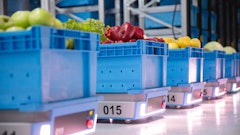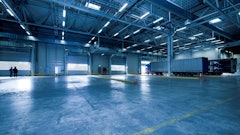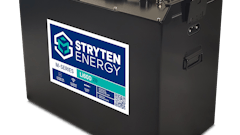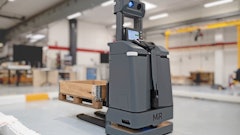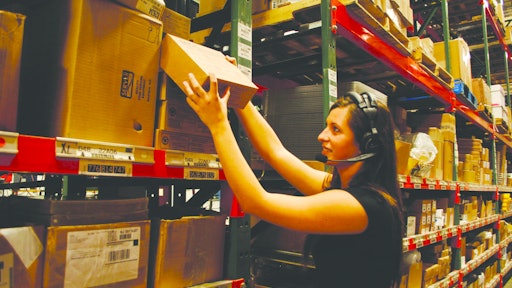
Warehouse managers, whether they are responsible for multiple facilities equipped with the latest in technology, or a simple operation that relies more on spreadsheets and clipboards, share a common goal—to run an efficient facility that gets product in and out in a timely manner.
Granted, some are more committed to improving their overall operations than others, but regardless of where they are on their journey, there are plenty of tools at their disposal to raise the bar on productivity.
Crawl before you walk
During his career, industry consultant David K. Schneider has watched the warehouse—and and what goes on inside of the four walls—become more elevated in the minds of supply chain executives. What was once considered a “cost control” issue is now viewed as a potential profit center that has a direct bearing on the bottom line for many companies.
“For a long time, businesses treated distribution and logistics and those who managed these functions as ‘the back room guys, the box kickers,’” he says.
Schneider understands the reasons for that perception. Years ago, when supply chains were referred to as “physical distribution,” each function, from procurement to accounts payable, operated independently from one another. There was hardly a holistic or “integrated view,” explains Schneider.
While working at a lumber company in the late 1980’s, Schneider saw an opportunity to streamline his company’s process enough to not only get lumber in front of his customers more quickly, but to get the financial transactions completed before the paper invoices hit the mailbox.
“This freed up over $2 million in working capital,” he remarks, simply because he was able to successfully “tie all the separate silos together.”
Schneider was not alone in realizing the potential impact of tying it all together.
“Enlightened companies started to figure out in the 1990s that if you paid attention to your warehouse and distribution, you might gain an extra 9 or 10 points of profit. Next, they started to understand that if they managed it better, they could free up additional working capital and invest it elsewhere, and maybe get an 8, 10, or twelve point return. Furthermore, if they were to reinvest in new systems that could help reduce inventory levels, they could create better margins or increase sales.”
As a consultant, Schneider chose the food and beverage industry as a key target, in part because the industry is comprised of so many smaller operators whose operations could benefit from his services.
There are a “significant population of players” who still use older technology, he explains, or in some cases, no technology at all.
“You would be surprised at the number of AS/400-based systems that are out there, or the number of companies that have no systems at all.”
Fortunately, there are myriad ways to boost warehouse productivity, says Schneider, and the fundamental steps don’t require anything more, frankly, than rolling up your sleeves.
“There are all sorts of things warehouse managers can do without spending capital. It just takes effort,” he says.
The first step is to evaluate your process, Schneider emphasizes. “Does each step make sense? If not, you’ve got a process problem.”
Schneider is a big proponent of process mapping, which can be done internally or in conjunction with outside help.
For example, “You can have someone come in and map your process. Then, have your own people map the process with white boards, flip charts, and sticky notes. After conducting a gap analysis, you’ll discover a variance. Look at it objectively, then decide which one is better and that will become the process to follow.”
Of course, once you establish a plan, you need to stick to it. It sounds trite, he says, but many companies deviate from the plan, in other words, “they don’t execute,” then are disappointed when they’re not getting the results they expected.
“Use pig-headed determination to root out all of the waste in your processes. Once you do that, you will not only create some productivity gains, you’ll find ways to free up some money and maybe some manpower too.”
There’s plenty that can be done in the warehouse to boost productivity, even without adding technology, “and you can do this today,” says Schneider. “When you’re ready to consider technology or mechanization, ask yourself, ‘What’s the smallest investment I can make initially that will yield the biggest result?’” he advises.
One example is cloud computing, which has made a host of software available—and more affordable—for smaller warehouse operators. Most times, it doesn’t make sense to invest in software that not only requires a considerable outlay up front, it will also need hardware and servers, IT support, and ongoing maintenance in the future.
As a rule of thumb, Schneider says that “an investment in technology should pay for itself in under a year, or it’s too expensive.”
Moreover, warehouse managers will likely have to get past the CFO if the investment in technology is substantial.
“The CFO wants to know the ROI, how fast it will be, and how sure you are of getting it,” Schneider points out.
Although a warehouse manager will naturally be attracted to productivity gains, “the CFO hears the word ‘productivity’ and they don’t know how to turn that into money,” says Schneider. “Maybe you’ve been able to implement a process that allows a worker to get his job done faster. But, then what are you going to do with him? Are you going to send that labor home so he’s off the clock? If that’s the case, then you need to monetize it. However, if he’s going to spend that extra time pushing a broom around, then you’ve just misallocated a resource,” he says. “If you can demonstrate to the CFO how you’re going to create cash for them, then you’re speaking their language.”
Schneider says some soul searching is not a bad idea either, starting with an honest assessment of how resistant or open you are to change.
“It sometimes takes a while for people to embrace change,” Schneider acknowledges. “But once they do, then things really start to move.”
Business owners who adopt a “warrior-like attitude because they are fed up with losing money” are good candidates for success, he adds.
PFG unleashes the power of voice picking
Performance Food Group (PFG) is a major player in the food distribution space, serving a range of customers from school systems to hospitals, hotels, and even prisons, throughout the country.
Prior to the implementation of a voice picking system offered by Voxware, which they are continuing to roll out to their network of distribution centers, PFG’s picking operation was largely pen and paper, recalls Jim Abbott, vice president of operations, Performance Foodservice, a division of PFG.
“A selector would grab a stack of orders, go to a location, then check-off on the paperwork that he had picked the correct product at that location. It was a very manual process,” he says.
Although other voice picking systems were considered, Voxware’s customer service was a huge selling point, says Abbott, noting that his experience with voice picking vendors earlier in his career helped him appreciate the value of a vendor who was there throughout the process, not to mention for post-installation support.
In addition to Voxware’s customer support, the voice picking system’s array of languages really impressed Abbott.
“In my facility alone, we have about 7 to 8 different languages spoken, including Spanish, Russian, and Chinese. Voxware speaks to the selector in his language, which means he doesn’t have to translate what he’s hearing.”
Obviously, there’s also a considerable amount of time saved when the selector doesn’t have to use his hands to write each time he picks product.
“Every second counts in the warehousing environment,” Abbott stresses.
Improved safety is another benefit, because the selector can pay more attention to driving his pallet jack.
Accuracy also improved with the voice picking system. “The system directs you to a location, then once you get there, you have to confirm your location with the system. If you’re at the wrong location, the system will announce ‘incorrect location, please go to location X.’ So, you shouldn’t have any mis-picks.”
The warehouse staff was equally excited about this feature, because too many mis-picks results in the worker being addressed by his superior.
Mis-picks are also costly to the company. “This is a huge issue,” says Abbott, “because the customer isn’t getting their product when they need it. And, you have product going out on a truck that needs to come back to the warehouse, while other product has to be re-selected and sent out.”
Prior to the Voxware installation, PFG’s mis-pick rate was 1.5 cases per 1000 selected. “Right now, in my facility, it’s dropped to 0.5 cases per thousand. We’ve cut our mis-picks down by two-thirds,” he says.
Abbott has also seen remarkable savings when it comes to training staff. “One of the huge benefits that we experienced was in training. The voice picking system cut the time in half. Before we had Voxware, we had an 8-week training program, in part, because of all the different languages our staff spoke. In fact, the normal training period without a voice system is 6-8 weeks in our industry. Voxware cut that training time in half. We’re now down to 3-4 weeks.”
All told, from the initial installation of hardware and antennas to going ‘live,’ the entire process took four months, says Abbott.
As it turns out, the biggest obstacle was introducing change to the staff. “It can be a rough area,” admits Abbott. “You’ve got some workers who have been doing this job for 10-15 years and now you’ve taken their world and flipped it upside down.”
According to Voxware’s Steve Gerrard, vice president, marketing and strategic planning, “Voice in the warehouse is still in the early adopter phase. It’s got roughly 11-17 percent market penetration. There are still plenty of companies out there that could benefit from this type of system.”
Voxware is one of only a few vendors that concentrate on voice in the warehouse, he says. “That’s what we’ve been doing for over 10 years. We are one of the two earliest providers of voice; we’re number two in the marketplace behind Vocollect.”
Gerrard understand his customers’ concerns. “Productivity is a huge issue in the warehouse, particularly in North America. The single highest cost a warehouse has is its labor pool. So, if there’s anything that can be done to help improve worker productivity, it will get noticed. Furthermore, it’s estimated that half of the cost spent on labor is for order fulfillment—the people that pick things from the shelves and pack them—and that’s where voice is usually implemented first.”
Voxware delivers the software and sometimes will deliver the hardware that the system runs on as well, says Gerrard.
In fact, it was a move by hardware manufacturers that helped make voice picking systems much more affordable, particularly Motorola and LXE, whose voice-only devices are designed to be used with a voice application and nothing else.
“When Motorola introduced their voice-only wearable device, that was a strong signal that the major manufacturers were serious about getting market share in this space. Likewise, the acquisition of Vocollect by Intermec was also significant. Overall, these developments helped drive down the cost of the hardware substantially,” Gerrard explains.
“If your were one of the early voice implementers, it was not uncommon to spend $5000 to $10,000 for every voice unit, but nowadays that price is under $2000. Voice has followed the typical trajectory of all high-tech—it started out as a proprietary solution, which meant you had to purchase a device from a boutique manufacturer and get custom-made software.”
Companies in the market for a voice picking system need to realize that the quality of the voice recognition software is the most important consideration, according to Gerrard.
“The software has to be able to recognize what the worker is saying. It may seem obvious, but there are a number of companies that have jumped into the market with inexpensive, consumer-oriented software, such as that used for airline reservations systems. However, warehouse environments are a lot noisier and the results are not the same.”
The ‘secret sauce’ for Voxware is their configurable system, along with their continuous recognition capability, which means the system can recognize long phrases of words, e.g. “I am at location X and I’ve just picked up six cases of product X,” versus having to split the phrase up into two parts.
In addition, “Our product is agnostic as to whether the worker is using voice or a scanner. The configurability aspect means the worker can speak it in or scan it in. Configurability also reduces the need for excessive (or unnecessary) coding,” says Gerrard.
These features were among those that attracted PFG to the Voxware system.
“They wanted three things: rapid deployment, open architecture, and scalability,” says Gerrard. “PFG didn’t want a long implementation time that would drive up costs. Secondly, they wanted an open architecture so they could have options around hardware devices and vendors. And thirdly, they needed it to scale up to support all of their DCs.”
Rather than installing hardware in each facility, PFG uses a centralized computer center to support their DCs. It saved the company considerable money because they didn’t have to duplicate infrastructure at each DC and furthermore, it’s much easier to support the system from a central location.
As for the ‘next big thing’ for voice picking applications, Gerrard sees the technology expanding beyond order fulfillment.
“There are companies that are looking at the benefits of doing hands-free work in other areas such as loading, and replenishment, and put-away.”
There’s also plenty of room to grow for offerings aimed at managers. “We’re announcing an update to our product that will enable the manager to run the console from an iPad or other tablet device,” says Gerrard.
Better warehouse management, locally and globally
Not only do small and large warehouse operators approach productivity with different priorities, there are differences between U.S. and European operators, according to Donal MacDaid, vice president of supply optimization for Aldata Group, a leading global player in retail and distribution optimization.
For starters, prior to the formation of the European Union, which led to standardized and harmonized customs processes, the movement of goods throughout Europe meant multiple border clearances and ultimately higher supply chain costs. European retailers, therefore, were keenly focused on managing their inventory, explains MacDaid. This was in contrast to U.S. retailers, whose attention was on merchandising and selling the product, and less on inventory optimization during that time.
There were exceptions, such as Walmart, which has long understood the value of supply chain management as a competitive differentiator, MacDaid points out.
However, “In recent years, we’ve seen more U.S. companies begin to focus on inventory management and optimization because it reduces inventory levels and reduces cost,” he says.
Other factors, such as longer and more complex supply chains, rising fuel costs, and new consumer channels, are pushing companies to optimize their inventory, says MacDaid.
The new consumer channels include “mobile computing and social networking,” he says, part of the broader e-commerce sector. “This adds a lot of complexity to the supply chain and raises questions like, ‘Where am I going to keep my inventory?’ Also, consumers today want to have the option to buy an item in one store location and return it the next day at another location 500 miles away.”
The proliferation of e-commerce has created other consumer channels, too. In France, the “drive” concept is extremely popular, according to MacDaid. These “hypermarchés drive” or drive-through hypermarkets offer a vast range of products, about 50 percent grocery products, and 50 percent non-grocery.
Customers have the option to either drive up to an electronic terminal at the “drive,” place their order and pick it up at the service point, which takes about 5 minutes, or they can pre-order online via their smartphone, tablet PC, or computer.
The importance of inventory optimization in this setting cannot be overstated. This retail model would simply not work without the support of a robust inventory management operation.
According to a recent e-commerce study by comScore, during July 2011, online retail sites in France attracted nearly 39.4 million unique visitors, reaching 83 percent of the Internet audience in France. A total of 43.7 million hours were spent on retail sites, representing 3.8 percent of total time spent online in France. And on average, each visitor spent 1.1 hours on retail sites, consuming 131 pages during the single month.
Meanwhile, in the U.S., e-commerce is expected to sustain double-digit growth rates in 2011, according to comScore.
Intelleflex, a leading provider of on-demand data visibility solutions, is another company that is making it easier for warehouse operators and supply chain executives to better adapt to changing consumer demands, more stringent government regulations, and more globalized supply chains.
This year, the company has received quite a bit of recognition for their XC3 Technology multi-mode readers and tags, which feature an innovative battery assisted passive RFID technology.
“Our technology allows constant monitoring of conditions inside the carton,” explains Peter Mehring, CEO of Intelleflex. For the food and beverage industry, that means total visibility of the food supply chain from product origin to the final consumer. In addition, the technology helps to not only reduce waste and boost sales it also improves food safety for consumers.
The company’s technology paved the way for an interesting alliance with The Hartford Financial Services Group, announced in August, to explore insurance-related opportunities to reduce the amount of produce lost and improve the overall quality of produce as it travels from the grower to the retailer.
Considering that one-third of shipped produce is wasted each year due to supply chain inefficiencies, representing $35 billion annually, this is a significant development. Equally, if not more important, is the impact this could have on humanitarian efforts to reduce world hunger.
According to the UN’s World Food Programme, the largest international food aid organization in the world, “Logistics is at the heart of what we do…it is often a matter of life and death.”







